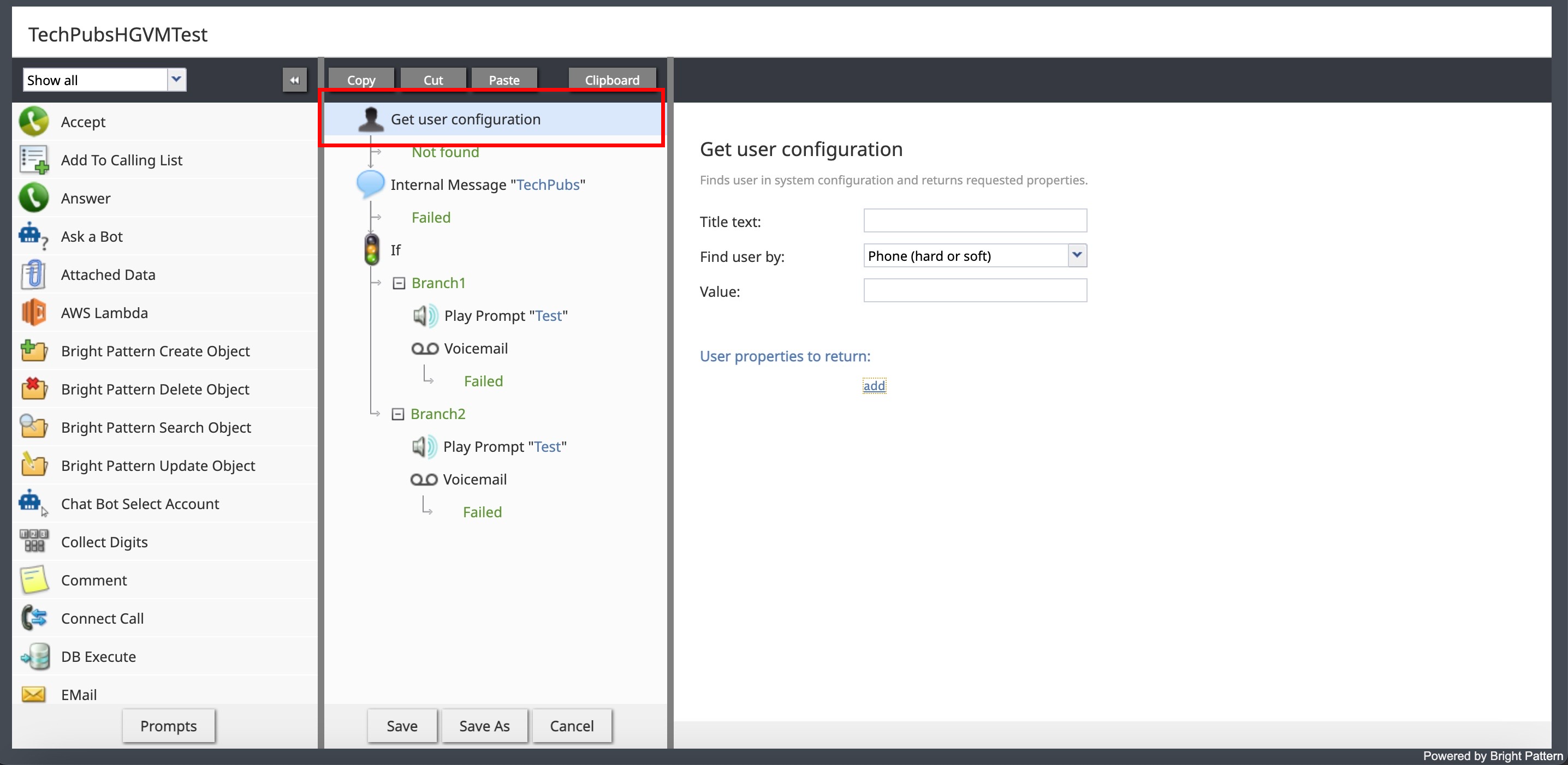From Bright Pattern Documentation
(Updated via BpDeleteTranslateTags script) |
Wyler.metge (talk | contribs) (→Settings: clarifications based on trac #37254) |
||
| Line 21: | Line 21: | ||
; User properties to return | ; User properties to return | ||
| − | : Click ''' | + | : If a user is found based on the ''Find user by'' and ''Value'' criteria, you can assign one or more of the user's properties to a variable. This variable can then be accessed elsewhere in the workflow. Click '''Add''', select the desired ''User property'', and indicate the ''Variable name'' to store the property's value: |
:* '''First Name''' – The user’s first name | :* '''First Name''' – The user’s first name | ||
:* '''Last Name''' – The user’s last name | :* '''Last Name''' – The user’s last name | ||
| Line 49: | Line 49: | ||
* '''User Type''' - Indicates "hunt group" representing that the user found is a group and not an individual user <br></br> | * '''User Type''' - Indicates "hunt group" representing that the user found is a group and not an individual user <br></br> | ||
| − | Scenario | + | Scenario variable names are specified as strings and are referenced using the ''$(varname)'' format. For example, if ''last.name'' is specified as the variable name, its value can be retrieved elsewhere in the workflow using ''$(last.name)''. |
For more information, see ''Contact Center Administrator Guide'' sections [[contact-center-administrator-guide/Users|Users]], [[contact-center-administrator-guide/Teams|Teams]], and [[contact-center-administrator-guide/SkillLevels|Skill Levels]]. | For more information, see ''Contact Center Administrator Guide'' sections [[contact-center-administrator-guide/Users|Users]], [[contact-center-administrator-guide/Teams|Teams]], and [[contact-center-administrator-guide/SkillLevels|Skill Levels]]. | ||
| + | |||
| + | [[File:WB-Get-User-Configuration-Settings-54.png|center|thumb|380x380px|Get User Configuration settings]] | ||
Revision as of 07:35, 23 September 2024
Get User Configuration
The Get User Configuration scenario block obtains one or more of the properties of a user, such as username, phone number, email address, or unique identifier, and saves them in scenario variables for future use.
Settings
- Title text
- Title text is the name of the instance of the block. Enter a name in the text field and click the Update button at the bottom of the Edit pane. The new name of the block appears in the flowchart.
- Find user by
- Find user by specifies the type of the property that will be used to find the user. You can find a user by using the following properties:
- Login ID – The username
- Email address – The user’s email address
- Phone – The user’s assigned phone extension or default hardphone number
- User ID – The global unique identifier of this user in system configuration; global identifiers can be used, for example, to associate contacts/cases/interactions in third-party systems with agents who handled them
- Value
- Value specifies the value of the property that will be used to find the user.
- User properties to return
- If a user is found based on the Find user by and Value criteria, you can assign one or more of the user's properties to a variable. This variable can then be accessed elsewhere in the workflow. Click Add, select the desired User property, and indicate the Variable name to store the property's value:
- First Name – The user’s first name
- Last Name – The user’s last name
- Login ID – The user’s username
- Email address – The user’s email address
- Softphone number – The user’s phone extension
- Hardphone number – The user’s default hardphone number
- Team ID – The global unique identifier of the user’s team in system configuration
- Team name – The name of the user’s team
- Voice Mail Greeting URL –
- Skill – The identifier of user’s skill from the specified group with a non-zero value; this parameter can be used for group-based routing (other users with the same skill); see the description of option Specific skill from variable of the Find Agent block for more information
- User ID – The global unique identifier of this user in system configuration; user ID can be used, for example, to associate contacts/cases/interactions in third-party systems with agents who handled them in order to facilitate personal routing; see the description of option Specific agent of the Find Agent block for more information.
- User Type - Indicates "user" or "hunt group" representing that the user found is an individual user or a hunt group
If the search criterion is Phone (hard or soft) and the phone number found is associated with a hunt group, the fields return the following information:
- First Name – The hunt group's name
- Last Name – none
- Login ID – none
- Email address – The email address of the user indicated in the Use voicemail box of field for the hunt group
- Softphone number – none
- Hardphone number – none
- Team ID – none
- Team name – none
- Voice Mail Greeting URL – The hunt group’s custom greeting URL if one exists or the tenant’s default voicemail greeting URL
- Skill – none
- User ID – The global unique identifier of the user specified in the Use voicemail box of field for the hunt group
- User Type - Indicates "hunt group" representing that the user found is a group and not an individual user
Scenario variable names are specified as strings and are referenced using the $(varname) format. For example, if last.name is specified as the variable name, its value can be retrieved elsewhere in the workflow using $(last.name).
For more information, see Contact Center Administrator Guide sections Users, Teams, and Skill Levels.


